Snowball soup and other interesting recipies
- Thread starter Wayland
- Start date
-
Come along to the amazing Summer Moot (21st July - 2nd August), a festival of bushcrafting and camping in a beautiful woodland PLEASE CLICK HERE for more information.
You are using an out of date browser. It may not display this or other websites correctly.
You should upgrade or use an alternative browser.
You should upgrade or use an alternative browser.
Scots_Charles_River
Bushcrafter (boy, I've got a lot to say!)
"I used an Alpkit down bag nested in a Nanok synthetic one all inside a breathable bivi bag. My hope was that any vapour would migrate into the synthetic bag before condensing. This seemed to work well."
No, it's a mix of two types.
No, it's a mix of two types.
"I used an Alpkit down bag nested in a Nanok synthetic one all inside a breathable bivi bag. My hope was that any vapour would migrate into the synthetic bag before condensing. This seemed to work well."
No, it's a mix of two types.
I'm not sure what you think is a problem with that?
"I used an Alpkit down bag nested in a Nanok synthetic one all inside a breathable bivi bag. My hope was that any vapour would migrate into the synthetic bag before condensing. This seemed to work well."
No, it's a mix of two types.
It's a pretty well established technique. The fact that one bag is down and the other synthetic should not make a difference.
Scots_Charles_River
Bushcrafter (boy, I've got a lot to say!)
I'm not sure what you think is a problem with that?
Hold fire !
Just quoted the post to answer the posters - Survivor - question. Was not makin any judgements just answered that it was not a British army bag. Don't have a problem with anything, in fact I use a Nanok bag myself.
Sorry that came across as brusque, I wasn't having a go, I was just puzzled, I didn't notice the earlier question.
Must have passed me by, it was back in June and I wasn't on much around then.
Must have passed me by, it was back in June and I wasn't on much around then.
Thank you very much.
I'm planning my next trip at the moment so look out for another thread in April or so.
I'm planning my next trip at the moment so look out for another thread in April or so.
Hi all, just reviving his old(ish) thread to get afew answers.
Are these British army cold weather sleep systems?

<Snip
Many Cheers,
Survivor
Sorry, forgot to answer your question your question here.
As mentioned above, the bags were an Alpkit Down bag on the inside of a Nanok Synthetic bag. Not British Army ones.
The other items you were asking about were other peoples kit so I can't answer for them I'm afraid.
Sorry about the delay.
Last edited:
Just been through and updated all the image links. I forgot that I moved these onto a new site a while ago.
Part 4
Sunday: No matter how much you plan there is always something that gets forgotten.
In this case I hadn't noted down the rendezvous time. I knew it had been changed from the original time and I had a vague memory that it was 11:00 but because I wasn't sure I was at the airport from just after 09:00.
There were not many tracks in the new snow so I didn't think I'd missed it.
The roads were easier for a bit of fresh snow. The temperature was still a mild 0°C. I sat and watched the world go by to see what happened.
I must admit that by now I was looking forward to some company. Solitude is great at times but it's also nice to share experiences sometimes.
11:00 turned out to be correct.
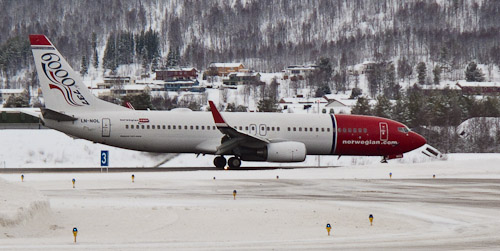
Woody drove up in a van for all the gear just after a plane had landed, people then started appearing out of the arrivals area while Pete and Lennart hauled themselves down the approach road.
We were all pointed in the direction of a bus and soon on our way to the farm which was to act as a support centre for the course.
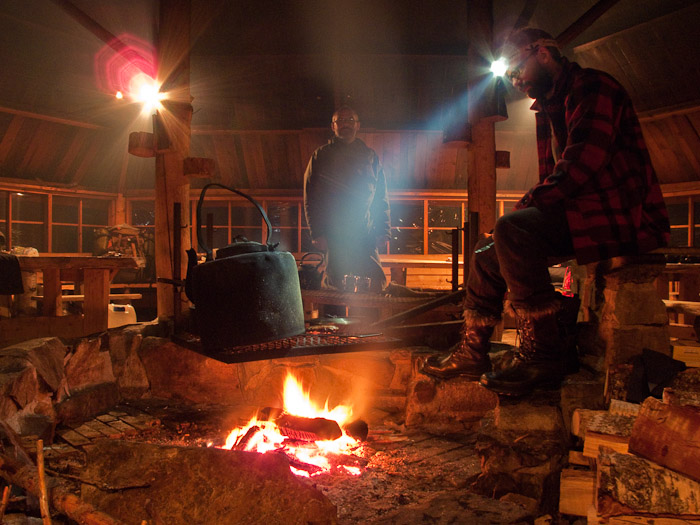
Dropping our gear off at the “Firehouse” it turned out we were to spend our first night in Katas with stoves we could use if necessary. First job was to sort traditional bedding out using coniferous vegetation thatched with birch twigs. Quite effective I must say.
It was a large investment in time for a single night but as it transpired, the tents were to be used for another course running at the same time so fair enough.
With nothing needing drying we decided not to bother with the stove for that evening.
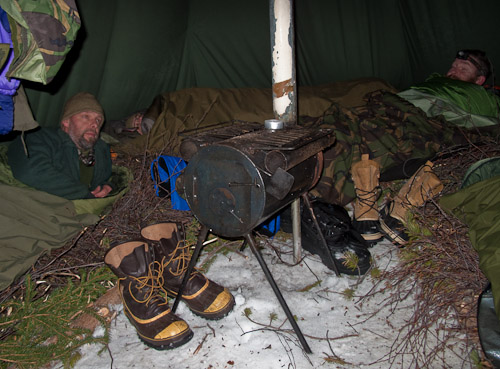
We returned to the Firehouse to cook and for a briefing on clothing and kit for the environment followed by time to sort out our packing for travelling to the course location in the morning.
By Monday morning it had blown up a bit of a hoolie with driving wet snow and one of the Laavus came down the hard way.
Chris the Cat's alarm went off at 05:00 instead of 07:00 which gave us some extra time to air the sleeping bags in the Firehouse.
Woody gave us notice that if the foul conditions continued we might hole up there a bit longer but before long the weather broke and we set off up the track and into the woods.
Because the sleds were at the back we got caught up in a twisted path cut by the walkers which was a bit of a mistake. We would have been better off cutting a straighter trail on fresh snow but that was a lesson we learned.
We were going to build the shelters that we would use and sleep in for the rest of the course. Woody showed us the Sledge knot, a useful little knot for fastening two spars together and then most of the other participants took a trip to the local supermarket for provisions.
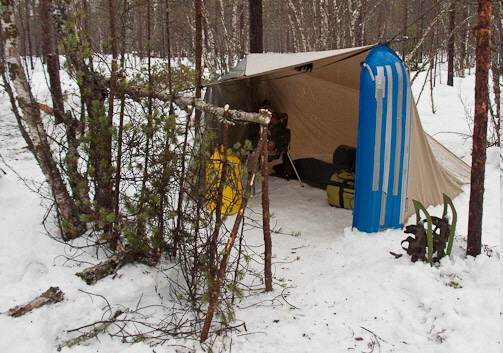
In theory I could cut anything I liked for my shelter but I've never really felt comfortable cutting live wood for such a temporary purpose.
I had a couple of tarps and some cordage so I quickly threw up a simple shelter.
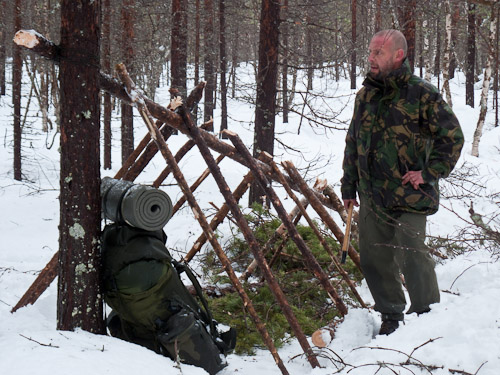
Most took the opportunity to build sturdy frames for their tarps that might seem wasteful in UK woodland but here provided a useful service to the farm owner, thinning his woodland somewhat.
In addition to my trusty poly cotton tarp I had brought a silvered plastic tarp/reflective blanket. This saw much use over the fortnight and certainly earned it's place in future kit lists for this environment.

I'm not normally a fan of plastic tarps or even lightweight synthetic ones for that matter. I find they tend to flap noisily in the wind.
Something I soon discovered on this trip though is that they also shed snow a lot better than poly cotton and when frozen the noise is pretty similar anyway.
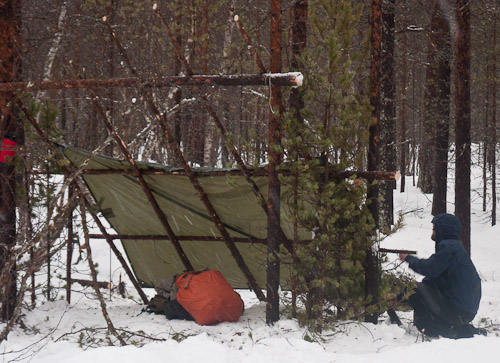
The plastic tarps seemed to hold up fairly well against sparks from the fires and at the end of the day are cheap and easy to replace.
Some made natural beds while others like myself relied upon the bedding we had brought with us.
Pete and Shane were my next door neighbours and were ambitiously building a large lean to but as the snow began to fall again and with the light fading I offered to build a fireplace for them if I could share it for cooking.
This saved us running two fires, needing twice as much firewood and seemed a satisfactory arrangement.
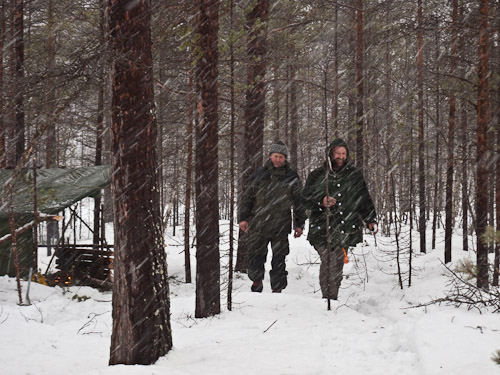
Sunday: No matter how much you plan there is always something that gets forgotten.
In this case I hadn't noted down the rendezvous time. I knew it had been changed from the original time and I had a vague memory that it was 11:00 but because I wasn't sure I was at the airport from just after 09:00.
There were not many tracks in the new snow so I didn't think I'd missed it.
The roads were easier for a bit of fresh snow. The temperature was still a mild 0°C. I sat and watched the world go by to see what happened.
I must admit that by now I was looking forward to some company. Solitude is great at times but it's also nice to share experiences sometimes.
11:00 turned out to be correct.

Woody drove up in a van for all the gear just after a plane had landed, people then started appearing out of the arrivals area while Pete and Lennart hauled themselves down the approach road.
We were all pointed in the direction of a bus and soon on our way to the farm which was to act as a support centre for the course.

Dropping our gear off at the “Firehouse” it turned out we were to spend our first night in Katas with stoves we could use if necessary. First job was to sort traditional bedding out using coniferous vegetation thatched with birch twigs. Quite effective I must say.
It was a large investment in time for a single night but as it transpired, the tents were to be used for another course running at the same time so fair enough.
With nothing needing drying we decided not to bother with the stove for that evening.

We returned to the Firehouse to cook and for a briefing on clothing and kit for the environment followed by time to sort out our packing for travelling to the course location in the morning.
By Monday morning it had blown up a bit of a hoolie with driving wet snow and one of the Laavus came down the hard way.
Chris the Cat's alarm went off at 05:00 instead of 07:00 which gave us some extra time to air the sleeping bags in the Firehouse.
Woody gave us notice that if the foul conditions continued we might hole up there a bit longer but before long the weather broke and we set off up the track and into the woods.
Because the sleds were at the back we got caught up in a twisted path cut by the walkers which was a bit of a mistake. We would have been better off cutting a straighter trail on fresh snow but that was a lesson we learned.
We were going to build the shelters that we would use and sleep in for the rest of the course. Woody showed us the Sledge knot, a useful little knot for fastening two spars together and then most of the other participants took a trip to the local supermarket for provisions.

In theory I could cut anything I liked for my shelter but I've never really felt comfortable cutting live wood for such a temporary purpose.
I had a couple of tarps and some cordage so I quickly threw up a simple shelter.

Most took the opportunity to build sturdy frames for their tarps that might seem wasteful in UK woodland but here provided a useful service to the farm owner, thinning his woodland somewhat.
In addition to my trusty poly cotton tarp I had brought a silvered plastic tarp/reflective blanket. This saw much use over the fortnight and certainly earned it's place in future kit lists for this environment.

I'm not normally a fan of plastic tarps or even lightweight synthetic ones for that matter. I find they tend to flap noisily in the wind.
Something I soon discovered on this trip though is that they also shed snow a lot better than poly cotton and when frozen the noise is pretty similar anyway.

The plastic tarps seemed to hold up fairly well against sparks from the fires and at the end of the day are cheap and easy to replace.
Some made natural beds while others like myself relied upon the bedding we had brought with us.
Pete and Shane were my next door neighbours and were ambitiously building a large lean to but as the snow began to fall again and with the light fading I offered to build a fireplace for them if I could share it for cooking.
This saved us running two fires, needing twice as much firewood and seemed a satisfactory arrangement.

Last edited:
Part 5
For the first night, I dropped a large dead pine that actually provided us with wood for a few evenings. We later added two or three other dead standing trees to our woodpile and had more than enough to see us through.
Woody joined us under Pete and Shane's tarp for a convivial evening as the snow gathered all around us.
I used a few spare cut tree tops from the building debris and propped them against a make shift frame to act as a snow break in front of my entrance and by morning that precaution had proved it's value.
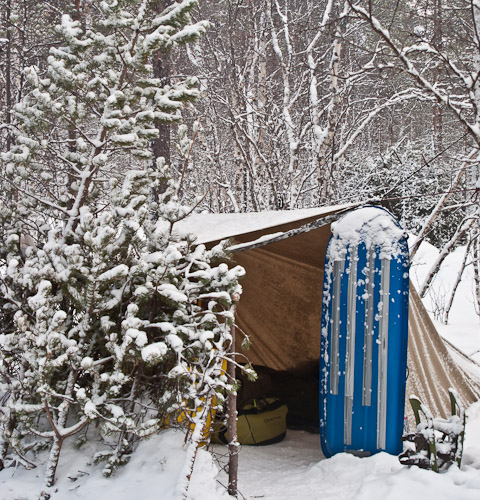
Tuesday: Snow on the tarp and some on the dry bags near the entrance but non at all on the bedding.
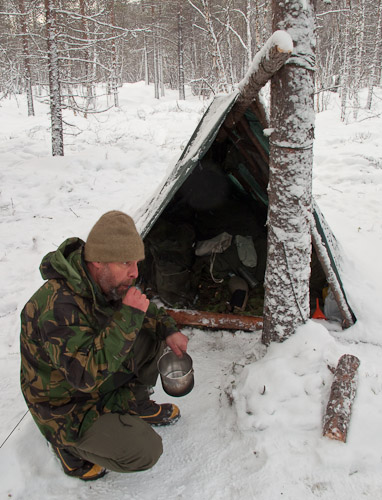
The days proceedings started, of course, with melting snow followed with breakfast. I was getting heartily fed up with porridge by now and wished I had stuck to my normal fare of fried bacon or sausages (Although my previous comments about Scandinavian sausages still holds true.)
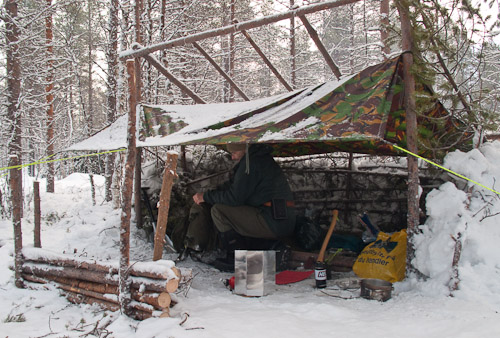
By living out in our own shelters part of the objective of the course was to develop the routines that make life not just sustainable but comfortable as well.
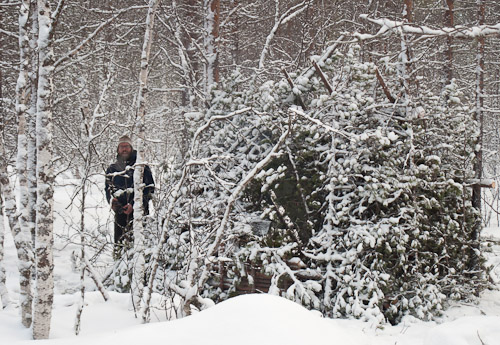
By taking a week out in advance of the course I felt I had things pretty sorted.
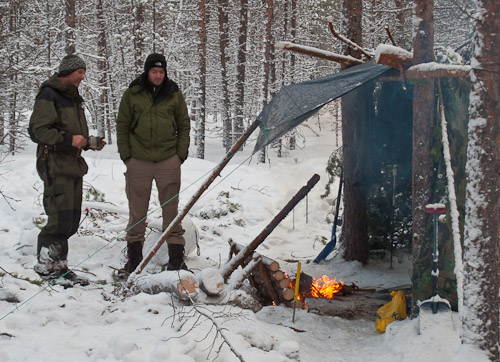
Others that had just arrived seemed to be coping well too. Temperatures were hovering around freezing point so it was wet snow we were dealing with but so far no major problems.
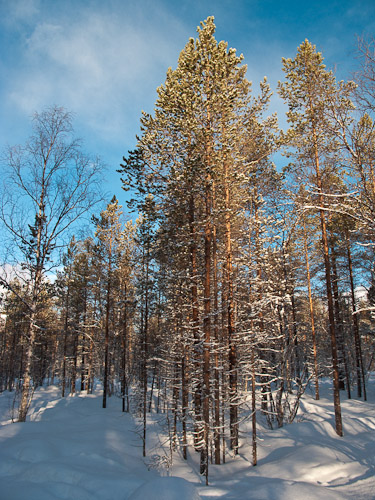
Working in this environment it is essential to remain organised. An axe sheath or even the axe itself soon disappears under fresh snowfall.
Clothing needs to be brushed down before standing anywhere near to a fire to prevent ice or snow from melting and soaking you through.
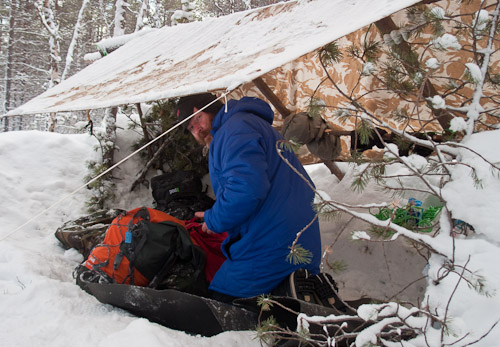
It is the little things like this that make the difference between comfort and hardship.
The schedule seemed quite relaxed but there was always something to do.
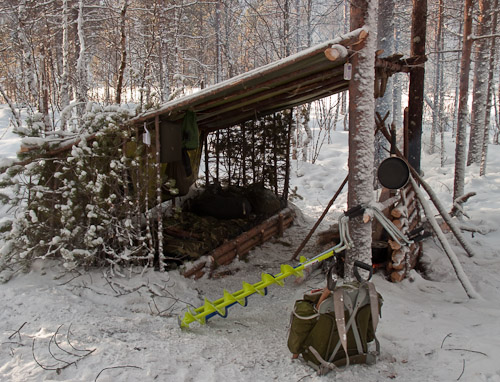
Once day sacks had been packed we were on our way to a local lake for our next tutorial.
After some instruction about ice safety and procedures it was out onto the ice to have a go with the ice drilling equipment.
The ice we were on was a little over a metre thick so little chance of penetrating it by any other methods.
These narrow holes would be the sort of thing we would be fishing through later in the week.
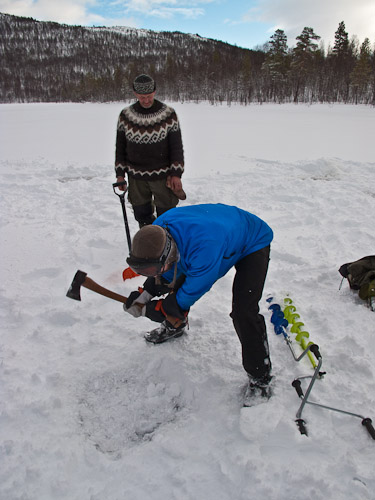
The next thing we were shown was how to use an axe to produce a hole big enough to drop a bucket into for water collection.
It seems a foolish thing to admit now but I couldn't help wonder how we were going to cut through a metre of ice with an axe?
In practice, you only need to dig deep enough for the bucket and the ice drill connects the bowl to the water underneath which then fills up the bowl.
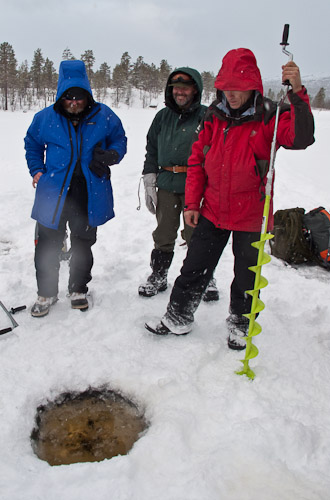
I can't believe I didn't think of that.
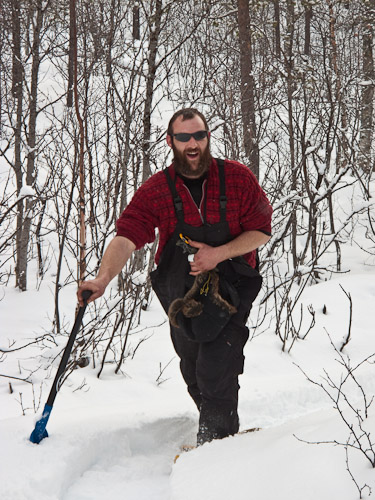
Back to camp for lunch. It had been bright in the morning but now it was snowing softly.
Ross gave us a quick lesson on carving a traditional style ice fishing rod and we then set about collecting the additional firewood we needed before cooking our main meal and settling fairly early to bed.
Wednesday: A short walk up the valley to find snow deep enough to make snow shelters.
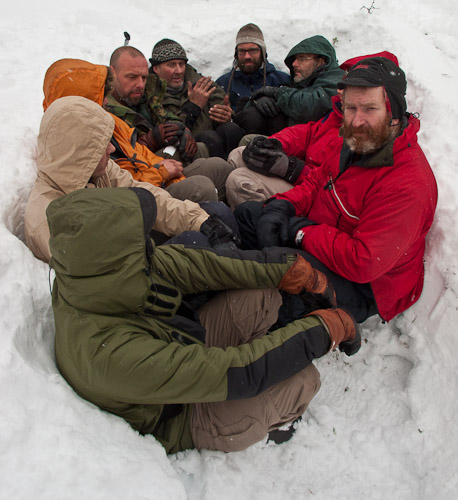
I'd read a lot about snow shelters in preparation for this trip and the initial snow wall that we built for an emergency shelter was no great surprise.
Possibly because most of the books on this subject are written for mountaineers I hadn't seen any suggesting the use of cut boughs and foliage to support a snow roof before.
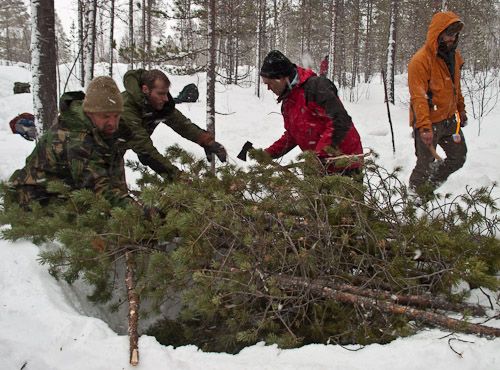
Fast to build and very effective.
With the addition of some bedding such a shelter could be very comfortable indeed.
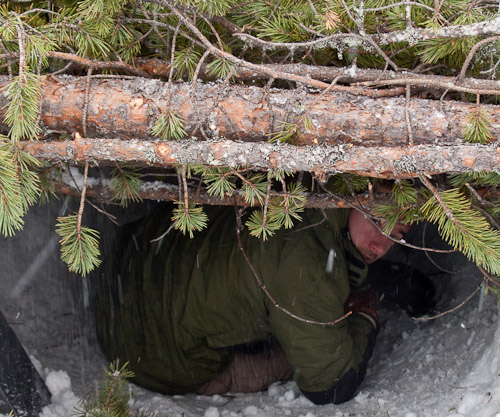
It is often such practical and simple ideas that get overlooked in books and courses like this can be a good way of helping you to cut to the chase.
This is an efficient shelter that is much faster to build than a quinzhee and in any kind of emergency situation such speed of construction could make all the difference.
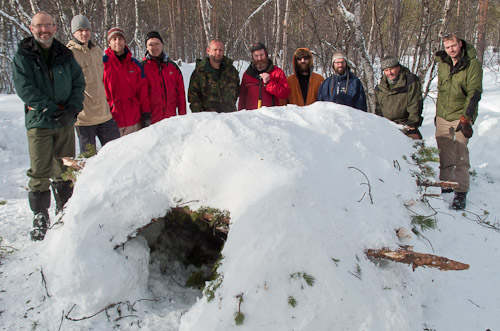
We all sat down for lunch around the shelter and while most of us tucked into a variety of cold snacks like salami, cheese or gorp, Woody gathered a few sticks, lit a fire and fried himself a meal of Blodpolse on Polarbröd. Now that's what I call style.
After lunch we were looking at tree felling in extreyy me cold. Unfortunately, at barely freezing temperatures, this would have to be just a basic tree felling lesson.
Apparently trees become much more unpredictable when semi frozen and safety becomes an even greater concern than it normally is.
Added to this the difficulty in moving quickly in the snow if things go wrong and the potential dangers soon mount up.
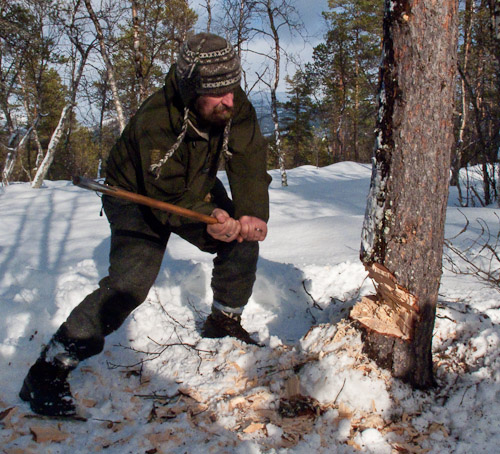
For this kind of job there really is no substitute for a decent axe.
While this might just have been possible with my little trailhawk it would have taken me all day.
In a little over 40 minutes with a medium sized axe we had the tree down, trimmed and sectioned ready to transport. That included teaching time.
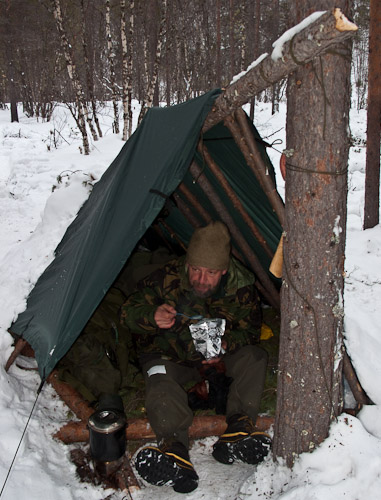
Back at camp the thawing / barely freezing conditions were making those camp routines even more important.
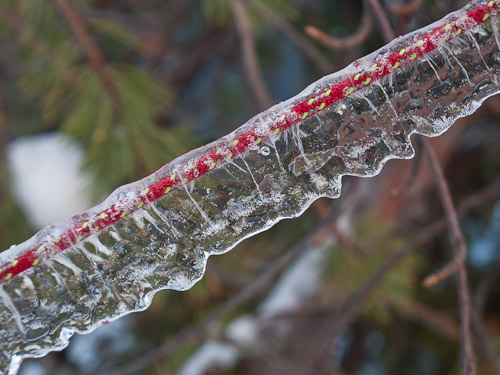
Tarps were getting wet and then freezing solid. Knots were seizing up. Condensation was seeping into everything not well sealed up. In many ways this was a lot more challenging than if the temperature had been ten degrees colder.
One thing that needs to be considered when melting snow for water is that it is a very good insulator.
A pot full of snow just put on the fire or over a stove can very quickly ruin your cooking pot.
The first thing that happens when the snow in the bottom of the pan melts is that it is soaked up by the snow above it.
That leaves a space between the pot and the snow which can heat up sufficiently to melt a thin aluminium pan or warp a steel one.
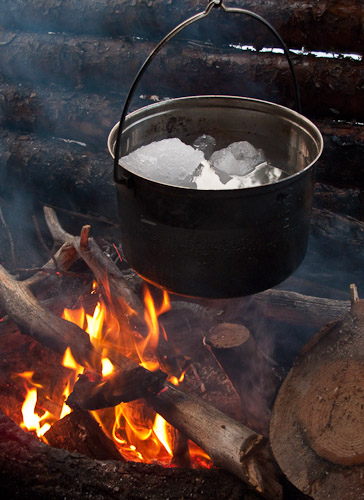
To solve this problem I tended to keep one water bottle purely for "sacrificial" water.
By heating this water and then dropping packed snowballs into it there was always liquid at the bottom of the pan to circulate the heat and melt the snow.
This led to the common description of this constant practice being "making snowball soup".
In the evening we returned to the lake to set up a few night lines under the ice and to see if we might see the Aurora.
We did get a show but nothing like I'd seen the week before. Disappointing for some I suspect but sadly that is the nature if such phenomena.
For the first night, I dropped a large dead pine that actually provided us with wood for a few evenings. We later added two or three other dead standing trees to our woodpile and had more than enough to see us through.
Woody joined us under Pete and Shane's tarp for a convivial evening as the snow gathered all around us.
I used a few spare cut tree tops from the building debris and propped them against a make shift frame to act as a snow break in front of my entrance and by morning that precaution had proved it's value.

Tuesday: Snow on the tarp and some on the dry bags near the entrance but non at all on the bedding.

The days proceedings started, of course, with melting snow followed with breakfast. I was getting heartily fed up with porridge by now and wished I had stuck to my normal fare of fried bacon or sausages (Although my previous comments about Scandinavian sausages still holds true.)

By living out in our own shelters part of the objective of the course was to develop the routines that make life not just sustainable but comfortable as well.

By taking a week out in advance of the course I felt I had things pretty sorted.

Others that had just arrived seemed to be coping well too. Temperatures were hovering around freezing point so it was wet snow we were dealing with but so far no major problems.

Working in this environment it is essential to remain organised. An axe sheath or even the axe itself soon disappears under fresh snowfall.
Clothing needs to be brushed down before standing anywhere near to a fire to prevent ice or snow from melting and soaking you through.

It is the little things like this that make the difference between comfort and hardship.
The schedule seemed quite relaxed but there was always something to do.

Once day sacks had been packed we were on our way to a local lake for our next tutorial.
After some instruction about ice safety and procedures it was out onto the ice to have a go with the ice drilling equipment.
The ice we were on was a little over a metre thick so little chance of penetrating it by any other methods.
These narrow holes would be the sort of thing we would be fishing through later in the week.

The next thing we were shown was how to use an axe to produce a hole big enough to drop a bucket into for water collection.
It seems a foolish thing to admit now but I couldn't help wonder how we were going to cut through a metre of ice with an axe?
In practice, you only need to dig deep enough for the bucket and the ice drill connects the bowl to the water underneath which then fills up the bowl.

I can't believe I didn't think of that.

Back to camp for lunch. It had been bright in the morning but now it was snowing softly.
Ross gave us a quick lesson on carving a traditional style ice fishing rod and we then set about collecting the additional firewood we needed before cooking our main meal and settling fairly early to bed.
Wednesday: A short walk up the valley to find snow deep enough to make snow shelters.

I'd read a lot about snow shelters in preparation for this trip and the initial snow wall that we built for an emergency shelter was no great surprise.
Possibly because most of the books on this subject are written for mountaineers I hadn't seen any suggesting the use of cut boughs and foliage to support a snow roof before.

Fast to build and very effective.
With the addition of some bedding such a shelter could be very comfortable indeed.

It is often such practical and simple ideas that get overlooked in books and courses like this can be a good way of helping you to cut to the chase.
This is an efficient shelter that is much faster to build than a quinzhee and in any kind of emergency situation such speed of construction could make all the difference.

We all sat down for lunch around the shelter and while most of us tucked into a variety of cold snacks like salami, cheese or gorp, Woody gathered a few sticks, lit a fire and fried himself a meal of Blodpolse on Polarbröd. Now that's what I call style.
After lunch we were looking at tree felling in extreyy me cold. Unfortunately, at barely freezing temperatures, this would have to be just a basic tree felling lesson.
Apparently trees become much more unpredictable when semi frozen and safety becomes an even greater concern than it normally is.
Added to this the difficulty in moving quickly in the snow if things go wrong and the potential dangers soon mount up.

For this kind of job there really is no substitute for a decent axe.
While this might just have been possible with my little trailhawk it would have taken me all day.
In a little over 40 minutes with a medium sized axe we had the tree down, trimmed and sectioned ready to transport. That included teaching time.

Back at camp the thawing / barely freezing conditions were making those camp routines even more important.

Tarps were getting wet and then freezing solid. Knots were seizing up. Condensation was seeping into everything not well sealed up. In many ways this was a lot more challenging than if the temperature had been ten degrees colder.
One thing that needs to be considered when melting snow for water is that it is a very good insulator.
A pot full of snow just put on the fire or over a stove can very quickly ruin your cooking pot.
The first thing that happens when the snow in the bottom of the pan melts is that it is soaked up by the snow above it.
That leaves a space between the pot and the snow which can heat up sufficiently to melt a thin aluminium pan or warp a steel one.

To solve this problem I tended to keep one water bottle purely for "sacrificial" water.
By heating this water and then dropping packed snowballs into it there was always liquid at the bottom of the pan to circulate the heat and melt the snow.
This led to the common description of this constant practice being "making snowball soup".
In the evening we returned to the lake to set up a few night lines under the ice and to see if we might see the Aurora.
We did get a show but nothing like I'd seen the week before. Disappointing for some I suspect but sadly that is the nature if such phenomena.
Last edited:
Part 6
Thursday: A quick demonstration to illustrate the dangers of getting buried in snow by a collapsing shelter. This involved burying each other but Bob more than most.
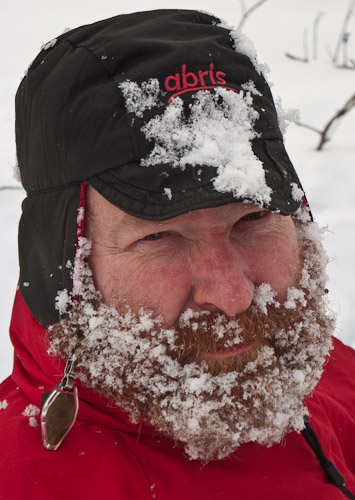
This is followed by a team effort to build a quinzhee.
It takes a lot of work to build one of these and this was just designed for two people. The principle is simple.
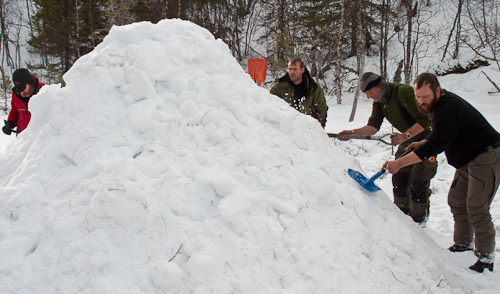
Make a large pile of snow, pack it down a bit and then poke sticks about 12 inches long into it. These sticks are to help you gauge the thickness of the walls as you dig it out from within.
With a little experience you can dispense with the sticks and judge it by the light filtering through the snow but we decided to go for the hedgehog method.
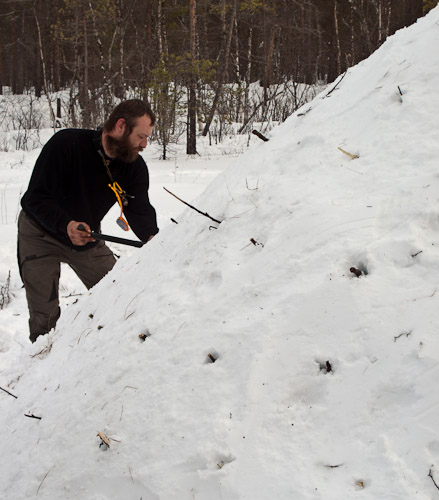
Once you have your pile you need to let it "set up"; for a while, during which time the snow consolidates and sets much harder.
Once this has been done you can then tunnel into the mound and excavate your shelter from the inside.
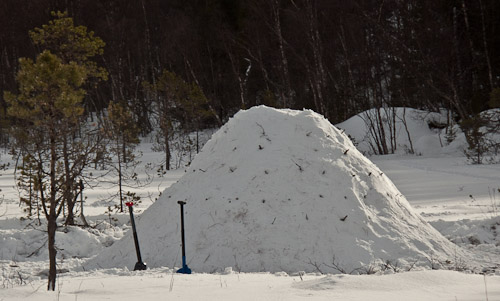
Ideally you keep your entrance hole quite low so that warmer air will be trapped in the upper parts of the quinzhee.
One approach is to cut a bigger hole for ease of access and then fill it back in when the inside has been dug out.
Ours seemed to fall in between these two schools with an entrance that was a bit high really but using the excavated snow to build a wind break at an angle to the entry way.
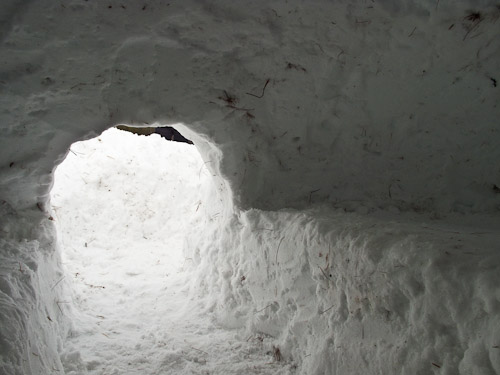
All that remained was a competition to decide who would sleep in it.
The first two people to make a sustainable fire in the area around the quinzhee get to use it for the night.
I had just emerged from an hours digging and shaping and thought I had no chance.
Pete beat me hands down, but much to my amazement, with the help of a handful of birch bark handed me by Ted, I came in second place.
The afternoon was spent back at the lake.
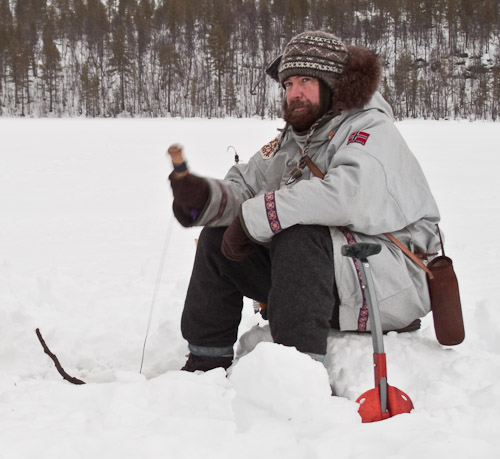
We checked the lines which had secured none of the wary fish below and then set about trying to tempt them with various jigs and lures. Again, unsuccessful.
We are told that the locals take lots of fish out of this lake, it's just a shame they don't put some back in so we can catch some.
As evening fell, the temperature was now well above freezing and raining too. Pete decided at the last minute that he was already struggling to keep his gear dry so a night in the Quinzhee was not likely to help.
That left me with a double sized shelter all to myself but with a thaw well in progress it turned out to be the least comfortable night of my stay.
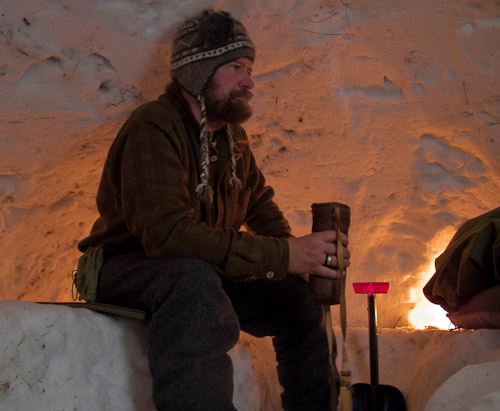
It was not cold but that was the problem.
The roof was domed so that most of the drips would run down to the sides but it was still damp and rather humid.
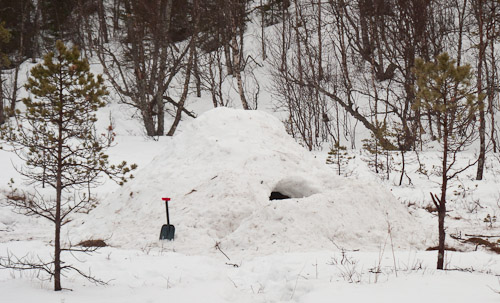
Friday: last day of the course. I struck camp soon after leaving the quinzhee. It didn't take long as there was no major structure to deal with.
One of the lads noticed some large paw prints running straight through the camp which interested Woody because something had attacked on of the sheep at the farm during the night.
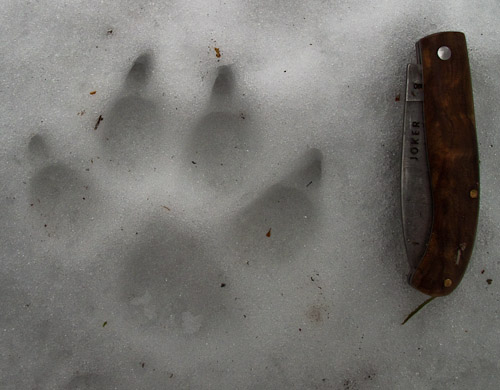
It looked like a large dog, somewhat bigger than the sled dogs on the farm.
In theory it could have been a wolf but if so it is from a very small population. They are critically endangered throughout Scandinavia and particularly in Norway.
This seemed a fitting time for Woody's final lesson of the course which was about trapping.
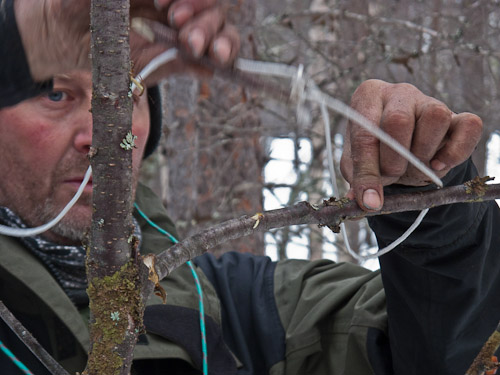
He demonstrated a number of ingenious methods, mostly based upon a simple toggle system.
To round off the course we all had to go off and create our own traps showing our understanding of that toggle system and for the most part we all succeeded.
A little time left to demolish our shelter structures, removing all cordage in the process before making our way back to the farm to collect a few belongings remaining there.
The course was formally ended but a few of us had two more days in the area before our flights home.
Thursday: A quick demonstration to illustrate the dangers of getting buried in snow by a collapsing shelter. This involved burying each other but Bob more than most.

This is followed by a team effort to build a quinzhee.
It takes a lot of work to build one of these and this was just designed for two people. The principle is simple.

Make a large pile of snow, pack it down a bit and then poke sticks about 12 inches long into it. These sticks are to help you gauge the thickness of the walls as you dig it out from within.
With a little experience you can dispense with the sticks and judge it by the light filtering through the snow but we decided to go for the hedgehog method.

Once you have your pile you need to let it "set up"; for a while, during which time the snow consolidates and sets much harder.
Once this has been done you can then tunnel into the mound and excavate your shelter from the inside.

Ideally you keep your entrance hole quite low so that warmer air will be trapped in the upper parts of the quinzhee.
One approach is to cut a bigger hole for ease of access and then fill it back in when the inside has been dug out.
Ours seemed to fall in between these two schools with an entrance that was a bit high really but using the excavated snow to build a wind break at an angle to the entry way.

All that remained was a competition to decide who would sleep in it.
The first two people to make a sustainable fire in the area around the quinzhee get to use it for the night.
I had just emerged from an hours digging and shaping and thought I had no chance.
Pete beat me hands down, but much to my amazement, with the help of a handful of birch bark handed me by Ted, I came in second place.
The afternoon was spent back at the lake.

We checked the lines which had secured none of the wary fish below and then set about trying to tempt them with various jigs and lures. Again, unsuccessful.
We are told that the locals take lots of fish out of this lake, it's just a shame they don't put some back in so we can catch some.
As evening fell, the temperature was now well above freezing and raining too. Pete decided at the last minute that he was already struggling to keep his gear dry so a night in the Quinzhee was not likely to help.
That left me with a double sized shelter all to myself but with a thaw well in progress it turned out to be the least comfortable night of my stay.

It was not cold but that was the problem.
The roof was domed so that most of the drips would run down to the sides but it was still damp and rather humid.

Friday: last day of the course. I struck camp soon after leaving the quinzhee. It didn't take long as there was no major structure to deal with.
One of the lads noticed some large paw prints running straight through the camp which interested Woody because something had attacked on of the sheep at the farm during the night.

It looked like a large dog, somewhat bigger than the sled dogs on the farm.
In theory it could have been a wolf but if so it is from a very small population. They are critically endangered throughout Scandinavia and particularly in Norway.
This seemed a fitting time for Woody's final lesson of the course which was about trapping.

He demonstrated a number of ingenious methods, mostly based upon a simple toggle system.
To round off the course we all had to go off and create our own traps showing our understanding of that toggle system and for the most part we all succeeded.
A little time left to demolish our shelter structures, removing all cordage in the process before making our way back to the farm to collect a few belongings remaining there.
The course was formally ended but a few of us had two more days in the area before our flights home.
Last edited:
Part 7
My original plan for the days after the course was to return to the area around the airport and find a quiet spot to camp for the last two nights before flying home. But here we were, in a stunning location just a 40 minute bus ride away.
Bob, Lennart, Pete, Shane and myself all decided to head back to the lake for the final nights.

There was a public fishing shelter there that we could use as a communal area and lots of places for pitching tarps, tents or even hammocks. We had left the night lines in place so that we could check them one last time. The only issue I had was getting to the airport in time for a potentially difficult check in before a three leg journey home.
The Norwegians have a good transport system that is well integrated. The bus timetable in this area is designed around the check in times at the airport.
This meant that I could be reasonably confident that, if I was at the bus stop in time, then I would be able to catch my plane. What a good idea...
Of course in the UK I would be a fool to trust such a system and that is perhaps why my original plan had been so cautious.
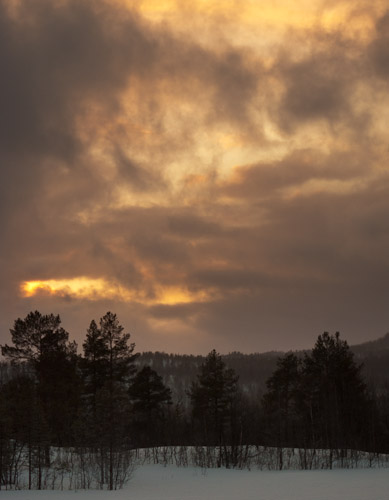
So it was that our merry little band found ourselves on Saturday evening watching reindeer crossing the ice under a watery sunset while concocting interesting recipes that would use up the last remains of our food supplies.
The sky was overcast and filled with the gentle but steady fall of snow.
The Northern lights flickered away in the sky brightly enough to occasionally illuminate the cloud base which meant there must have been a significant storm going on up there.
We finished the last of our "duty free"; and discussed plans and dreams for the future.
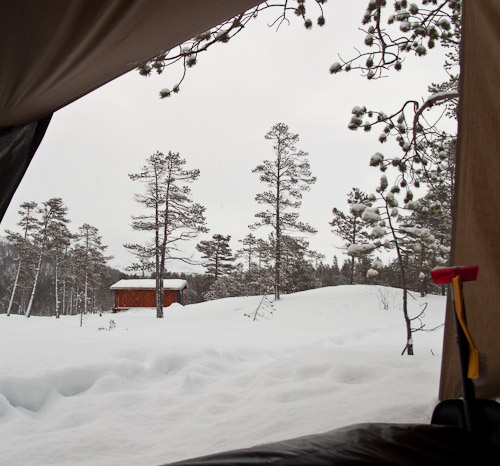
When I looked out from my sleeping bag in the morning the scene, with snow resting on the pine branches, reminded me not of Norway but of some of the beautiful Japanese Ukiyo-e woodprints that I have seen.
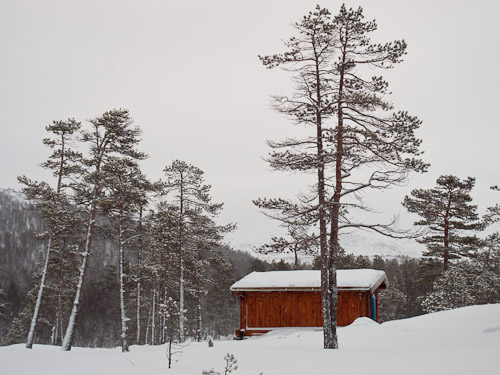
The other lads were intent upon an energetic plan to walk up to a mountain hut somewhere on the other side of the lake.
Maybe I'm getting a little old these days but I fancied a nice quite day by the lake, chilling out and taking pictures.
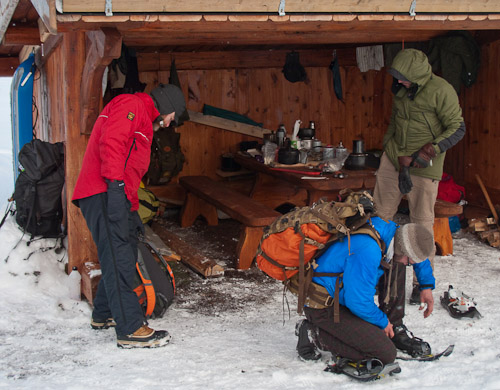
I lent Bob my snowshoes so he would not be at a disadvantage to the rest that had their own and watched the intrepid quartet as they tramped off into the wilderness.
I was left with the time they expected to return and the camp all to myself.
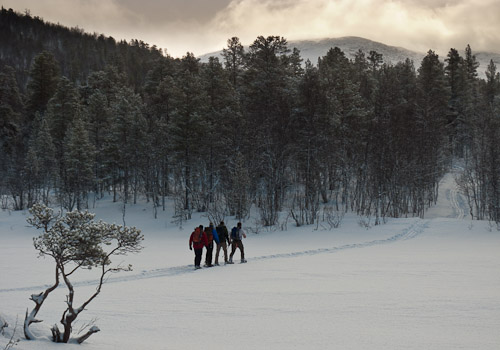
I wanted a couple of posed shots for my web site and I am often asked how I get those shots when I am obviously on my own.
Herein lies one of the great advantages of digital photography. With no expensive film to waste then there is nothing but battery power and the size of your memory cards to stop you from taking dozens of shots and just sorting them out on the computer at home.
I have already mentioned that I packed a tripod. For me a decent tripod is an essential piece of photographic equipment. I'm not talking about one of those flimsy little gadgets that looks like a good idea in a catalogue but has no place under a proper camera. My smallest tripod weighs in at two and a quarter kilos and I consider that too lightweight for serious work.
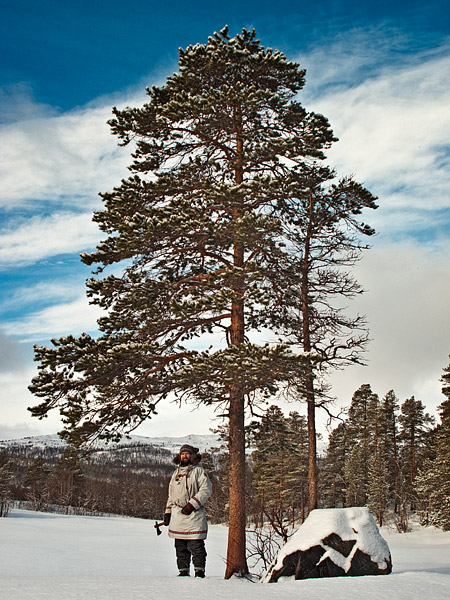
The other thing I find room for in my pack is a cable switch but mine also functions as an interval timer. I can set it to fire the camera shutter at regular intervals of any delay I like. I can set it to take a specific number of shots or just carry on until I stop it.
This allows me to set up a complicated shot if I need to or just get on with things and see if there are any shots that are usable later.
My original plan for the days after the course was to return to the area around the airport and find a quiet spot to camp for the last two nights before flying home. But here we were, in a stunning location just a 40 minute bus ride away.
Bob, Lennart, Pete, Shane and myself all decided to head back to the lake for the final nights.

There was a public fishing shelter there that we could use as a communal area and lots of places for pitching tarps, tents or even hammocks. We had left the night lines in place so that we could check them one last time. The only issue I had was getting to the airport in time for a potentially difficult check in before a three leg journey home.
The Norwegians have a good transport system that is well integrated. The bus timetable in this area is designed around the check in times at the airport.
This meant that I could be reasonably confident that, if I was at the bus stop in time, then I would be able to catch my plane. What a good idea...
Of course in the UK I would be a fool to trust such a system and that is perhaps why my original plan had been so cautious.

So it was that our merry little band found ourselves on Saturday evening watching reindeer crossing the ice under a watery sunset while concocting interesting recipes that would use up the last remains of our food supplies.
The sky was overcast and filled with the gentle but steady fall of snow.
The Northern lights flickered away in the sky brightly enough to occasionally illuminate the cloud base which meant there must have been a significant storm going on up there.
We finished the last of our "duty free"; and discussed plans and dreams for the future.

When I looked out from my sleeping bag in the morning the scene, with snow resting on the pine branches, reminded me not of Norway but of some of the beautiful Japanese Ukiyo-e woodprints that I have seen.

The other lads were intent upon an energetic plan to walk up to a mountain hut somewhere on the other side of the lake.
Maybe I'm getting a little old these days but I fancied a nice quite day by the lake, chilling out and taking pictures.

I lent Bob my snowshoes so he would not be at a disadvantage to the rest that had their own and watched the intrepid quartet as they tramped off into the wilderness.
I was left with the time they expected to return and the camp all to myself.

I wanted a couple of posed shots for my web site and I am often asked how I get those shots when I am obviously on my own.
Herein lies one of the great advantages of digital photography. With no expensive film to waste then there is nothing but battery power and the size of your memory cards to stop you from taking dozens of shots and just sorting them out on the computer at home.
I have already mentioned that I packed a tripod. For me a decent tripod is an essential piece of photographic equipment. I'm not talking about one of those flimsy little gadgets that looks like a good idea in a catalogue but has no place under a proper camera. My smallest tripod weighs in at two and a quarter kilos and I consider that too lightweight for serious work.

The other thing I find room for in my pack is a cable switch but mine also functions as an interval timer. I can set it to fire the camera shutter at regular intervals of any delay I like. I can set it to take a specific number of shots or just carry on until I stop it.
This allows me to set up a complicated shot if I need to or just get on with things and see if there are any shots that are usable later.
Last edited:
Part 8
Time once again to look at the gear I took and how it performed.
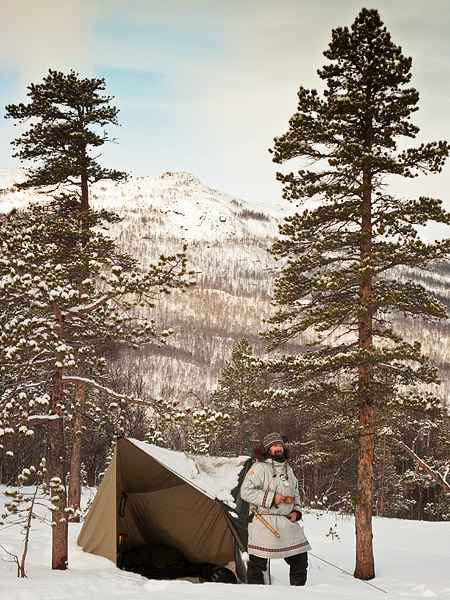
Clothing first: I relied mostly upon wool. A light base layer with a slightly thicker mid layer top under a Bison shirt and a Norwegian Army jumper with loop-stitched heavy base layer long johns under heavy wool trousers.
This was topped off with Ventile leggings and a Ventile and canvas parka when necessary.
For back up I had a down jacket which was used once and served the rest of the time as a pillow.
I also had a thin synthetic windproof top which was worn when digging snow holes and also to shed falling snow or even light rain. This was the only item to show damage over the fortnight in the form of a small hole melted by a spark from the fire.
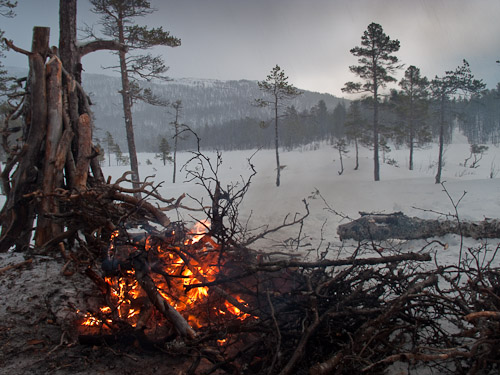
Boots were either Canadian Army Mukluks or pac boots which shared the same thick wool felt liners with one pair of wool socks inside.
The gloves I used most were cheap thin fleece gloves that just removed the chill but I also had leather gloves with wool liners which were used a few times and mittens with wool liners which were not.
On my head I had a Nepalese woollen hat with a fleece liner which served throughout and a merino head-over which was used occasionally.
Temperatures ranged between -16°C to about +3°C, activity between travelling in heavy snow or cutting wood to sitting about being idle.
I was comfortable throughout except when I failed to adjust my layers properly.
I carried spare liners, gloves and base layers which were largely unused.
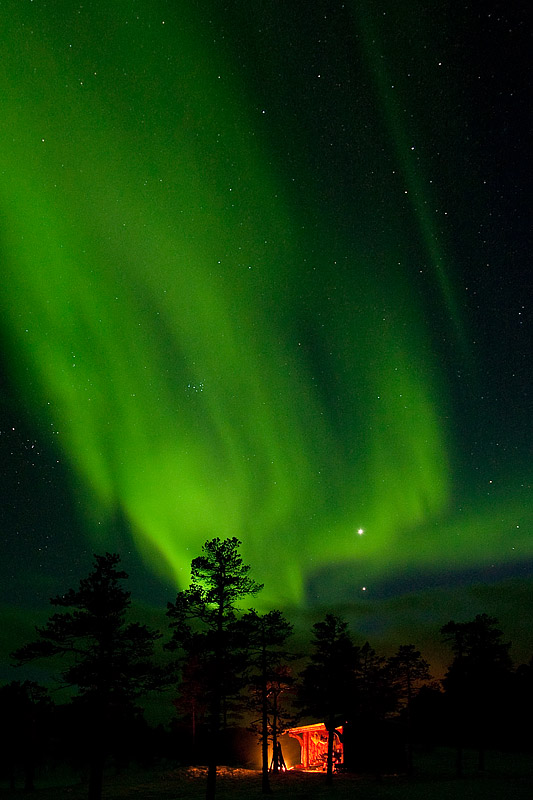
I found a good way to dry the boot liners was to hang them up with a bottle of hot water in the foot section overnight, which drove moisture towards the outer surface. In the morning this could be brushed off as frost and the water in the bottles was usually still liquid inside the liner.
Vuoddaga, similar to thin puttees were invaluable as was a stiff brush for removal of snow from outer clothing.
Apart from nights spent in Quinzhees I used a poly cotton tarp for shelter the rest of the time with an additional plastic tarp as a weather sheet.
On future trips I will give serious thought to just using decent plastic tarps for their ease of shedding snow.
A combination of down inner bag, synthetic middle bag with a moisture permeable bivi bag worked well but I also had a micro fibre towel that was sewn into a "snood" which absorbed a great deal of condensation from my breath instead of letting it get into the sleeping system. This was then easily dried inside my clothing during the day.
The pulk worked well but suffered on gritty roads. I would certainly use the method again but carry more duct tape for repairs. It was particularly useful for collecting firewood.
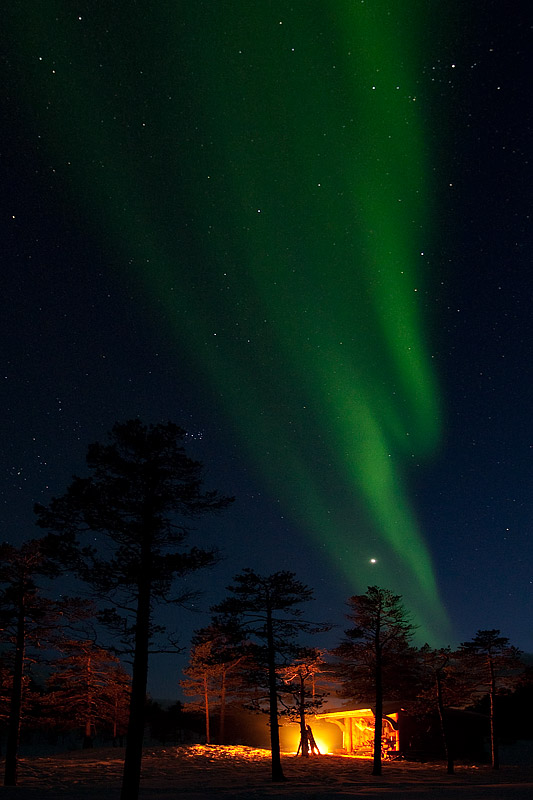
Having the pulk I did not have to rely upon light weight foods and in future I would take less porridge and more real food that can be fried for breakfast.
Norwegian fishcakes were really useful, they are pre cooked which means they are quick to head and work on their own or with a variety of different sauces for variety. The Thai green Norwegian fish cake curry was a particular highlight.
For me the non freezing properties of the Solbaer syrup was great help but they also make a powdered version which is good as well.
A decent thermos flask is very useful if for no other reason than ensuring you have water to start a snowball soup.
I also had a less well insulated cup with a flip top lid which I kept in a sheep skin carrier which was really useful to make sure I always had a ready drink on me.
Everyone has their favourite fire lighting equipment but for every day use I carried waterproof matches in ziplock bags in a variety of pockets. They worked well and were much more reliable than the one gas lighter I had with me.
I think I had one of the largest pans for melting snow but it would have been useful to have two that could be hung over the fire. Only one of mine had a bail wire, a situation which will soon be changed and I will also make some kind of heat spreader for the Trangia.
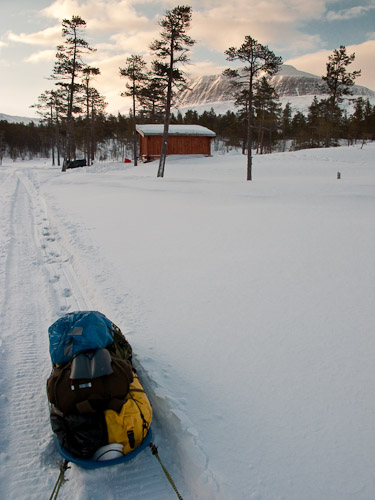
Well, our last night also gave us one of the best displays of the Aurora and following a pack up in the morning we set our toes in the direction of the bus stop and on to the airport.
This is when things started to go pear shaped.
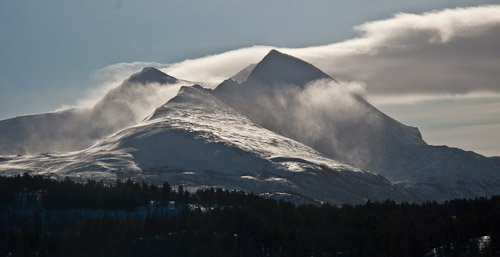
An SAS operative had assured me that I would be able to check my bags in for all three flights from Bardufoss to Manchester but the Norwegian Air operative at the check in desk said this was not possible.
That meant I had to check my bags in at Oslo five minutes before my plane landed. A neat trick if you can manage it.
Add to that the NA flight arrived late I had to abandon my bags at Oslo and run from one end of the terminal and back again to transfer to my SAS flight to Copenhagen which was just closing it's gates as I arrived.
Fortunately they let me on and I sat for most of the flight coughing, sweating and trying to get my breath back while most people around me must have thought I was a plague victim.
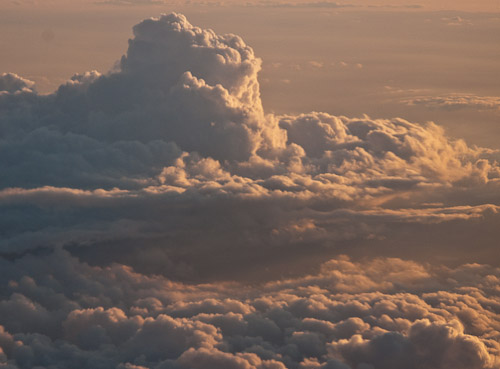
Fortunately the rest of the flight was uneventful.
I reported my missing luggage at Manchester and as I stepped into the arrivals lounge, Mike, a good friend caught my attention and chauffeured me home. My luggage arrived two days later.
A truly memorable trip, full of fine friends and characters. As I type these final words the last of my unpacking remains to be done downstairs. I suspect the gentle smell of woodsmoke will take longer to disperse but I'm already drawing my thoughts together to plan the next trip.
Time once again to look at the gear I took and how it performed.

Clothing first: I relied mostly upon wool. A light base layer with a slightly thicker mid layer top under a Bison shirt and a Norwegian Army jumper with loop-stitched heavy base layer long johns under heavy wool trousers.
This was topped off with Ventile leggings and a Ventile and canvas parka when necessary.
For back up I had a down jacket which was used once and served the rest of the time as a pillow.
I also had a thin synthetic windproof top which was worn when digging snow holes and also to shed falling snow or even light rain. This was the only item to show damage over the fortnight in the form of a small hole melted by a spark from the fire.

Boots were either Canadian Army Mukluks or pac boots which shared the same thick wool felt liners with one pair of wool socks inside.
The gloves I used most were cheap thin fleece gloves that just removed the chill but I also had leather gloves with wool liners which were used a few times and mittens with wool liners which were not.
On my head I had a Nepalese woollen hat with a fleece liner which served throughout and a merino head-over which was used occasionally.
Temperatures ranged between -16°C to about +3°C, activity between travelling in heavy snow or cutting wood to sitting about being idle.
I was comfortable throughout except when I failed to adjust my layers properly.
I carried spare liners, gloves and base layers which were largely unused.

I found a good way to dry the boot liners was to hang them up with a bottle of hot water in the foot section overnight, which drove moisture towards the outer surface. In the morning this could be brushed off as frost and the water in the bottles was usually still liquid inside the liner.
Vuoddaga, similar to thin puttees were invaluable as was a stiff brush for removal of snow from outer clothing.
Apart from nights spent in Quinzhees I used a poly cotton tarp for shelter the rest of the time with an additional plastic tarp as a weather sheet.
On future trips I will give serious thought to just using decent plastic tarps for their ease of shedding snow.
A combination of down inner bag, synthetic middle bag with a moisture permeable bivi bag worked well but I also had a micro fibre towel that was sewn into a "snood" which absorbed a great deal of condensation from my breath instead of letting it get into the sleeping system. This was then easily dried inside my clothing during the day.
The pulk worked well but suffered on gritty roads. I would certainly use the method again but carry more duct tape for repairs. It was particularly useful for collecting firewood.

Having the pulk I did not have to rely upon light weight foods and in future I would take less porridge and more real food that can be fried for breakfast.
Norwegian fishcakes were really useful, they are pre cooked which means they are quick to head and work on their own or with a variety of different sauces for variety. The Thai green Norwegian fish cake curry was a particular highlight.
For me the non freezing properties of the Solbaer syrup was great help but they also make a powdered version which is good as well.
A decent thermos flask is very useful if for no other reason than ensuring you have water to start a snowball soup.
I also had a less well insulated cup with a flip top lid which I kept in a sheep skin carrier which was really useful to make sure I always had a ready drink on me.
Everyone has their favourite fire lighting equipment but for every day use I carried waterproof matches in ziplock bags in a variety of pockets. They worked well and were much more reliable than the one gas lighter I had with me.
I think I had one of the largest pans for melting snow but it would have been useful to have two that could be hung over the fire. Only one of mine had a bail wire, a situation which will soon be changed and I will also make some kind of heat spreader for the Trangia.

Well, our last night also gave us one of the best displays of the Aurora and following a pack up in the morning we set our toes in the direction of the bus stop and on to the airport.
This is when things started to go pear shaped.

An SAS operative had assured me that I would be able to check my bags in for all three flights from Bardufoss to Manchester but the Norwegian Air operative at the check in desk said this was not possible.
That meant I had to check my bags in at Oslo five minutes before my plane landed. A neat trick if you can manage it.
Add to that the NA flight arrived late I had to abandon my bags at Oslo and run from one end of the terminal and back again to transfer to my SAS flight to Copenhagen which was just closing it's gates as I arrived.
Fortunately they let me on and I sat for most of the flight coughing, sweating and trying to get my breath back while most people around me must have thought I was a plague victim.

Fortunately the rest of the flight was uneventful.
I reported my missing luggage at Manchester and as I stepped into the arrivals lounge, Mike, a good friend caught my attention and chauffeured me home. My luggage arrived two days later.
A truly memorable trip, full of fine friends and characters. As I type these final words the last of my unpacking remains to be done downstairs. I suspect the gentle smell of woodsmoke will take longer to disperse but I'm already drawing my thoughts together to plan the next trip.
Last edited:
Sorry this thread has been mucked about a bit. I have once again repaired all the picture links but unfortunately this meant that the new forum software would no longer support the length of the original posts, which is why I've had to add the last bits on the end of the thread here.
I apologise for the inconvenience and I just wish I could repair some of my other posts as I have here but I can only do that in the Sub Zero Forum at present.
I apologise for the inconvenience and I just wish I could repair some of my other posts as I have here but I can only do that in the Sub Zero Forum at present.
Last edited:
Excellent trip report Wayland , sounds like a fantastic experience and a great learning opportunity , as ever your photographs are brilliant .
A joy to read this thread!
The tracks in the snow, I think Wolf. They are more common than people think, and now, 6 years after the trip, they are even around Stockholm in the south.
The tracks in the snow, I think Wolf. They are more common than people think, and now, 6 years after the trip, they are even around Stockholm in the south.
Similar threads
- Replies
- 21
- Views
- 2K
- Replies
- 60
- Views
- 2K
